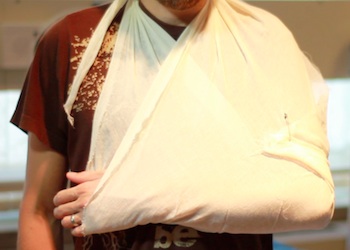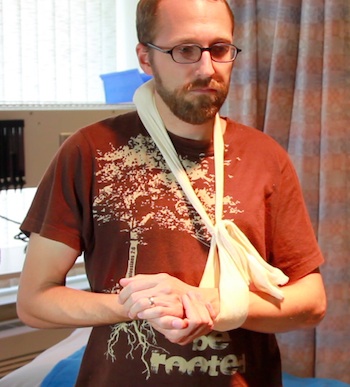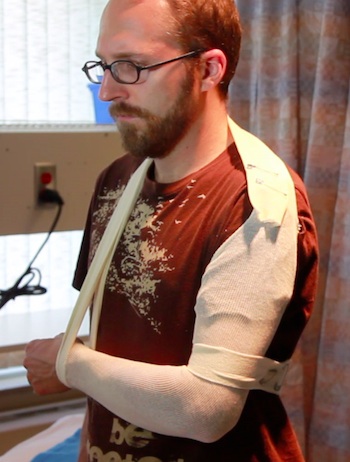
Slings - - NOTE - DRAFT
last authored: May 2013, David LaPierre
last reviewed:
Introduction
A sling is used to support and immobilize the arm following injury. Three slings are explained in this article - large arm sling, cuff and collar, and Vietnam sling, or shoulder immobilizer.
Splints and casts are also frequently used to stablize arm injuries; these are described here.
Assessment
main article: extremity trauma
When applying a sling, ensure appropriate wound care has been provided.
Assess the circulation, sensation, and motor function of the affected limb before and after application of a sling.
Check the circulation of the injured limb by blanching a fingernail and watching for return of colour within 2-3 seconds. Check sensation and motor function in the fingers as well.
If colour does not return, adjust, then take the sling off and loosen any other bandaging. Straighten the arm if possible. If circulation, sensation, or motor function doesn’t improve, seek further help immediately.
Large Arm Sling
- indications
- materials
- procedure
Indications

The large arm sling may be used with injury to the:
- clavicle
- upper arm
- forearm
- wrist
- rib
Materials
- triangular bandage
- safety pin
Procedure
Begin standing in front of the patient, having them support their arm.
Place the triangular bandage between the chest and the injured arm, placing the point behind the elbow of the injured arm.
Pull the end that is closer to the chest over the uninjured shoulder.
Supporting the forearm, raise the other end above the injured arm and tie the ends just above the clavicle on the uninjured side.
Fold the point over the elbow, tuck in excess fabric, and pin it in place with the point facing downwards in case it comes undone.
Make sure that the hand and wrist supported slightly higher than the elbow, all the way to the little finger.
Cuff and Collar
- indications
- materials
- procedure
Indications

Cuff and collar slings may be used for:
- limb support for injuries to the hand, forearm, elbow, or shoulder, especially while awaiting further assessment and management
- undisplaced or mildly displaced proximal humeral fractures
- clavicle fracture (not recommended by some)
Materials
- stockinette
- ABD or other padding (optional)
- tape (optional)
Procedure
Begin with the affected arm supported by the patient or an assistant to at least 90 degrees.
Drape the stockinette around the neck, and ensure it is flat around the neck. Cut so that it extends beyond the forearm at either end.
Insert padding into the stockinette and place behind neck. Do the same in the area that will be supporting the wrist.
Tie the stockenette to itself around the wrist. Tie the remaining end to this loop. Tape can be used to secure the knots.
Use in adjusting angulation
Placement of the collar n cuff about the wrist and the height at which the limb is placed can be used to alter the angulation of humeral fractures in conjunction with using gravity to exert a traction force reducing the fracture.
Lateral angulation can be corrected with dorsal placement of the wrist loop conversely medial angulation can be altered with volar placement of the wrist loop.
Anterior and posterior alignment can be altered by length of the collar. Too long a collar may result in anterior angulation as too short may result in posterior bowing. Follow up xrays are highly recommended to assess the alignment of a fracture. The limb must stay dependent with no support beneath it such as pillows. Sleeping in an erect or semi-erect position recommended.
Vietnam Sling
- indications
- materials required
- procedure
Indications

The Vietnam sling is helpful for immobilizing the arm for the following injuries:
- clavicle fractures
- AC joint separation/sprain
- reduced shoulder dislocation/subluxation
- stable proximal humeral fractures
The Vietnam sling functions in a similar way to commercially available shoulder immobilizers.
Materials Required
In order to fashion a Vietnam sling, you require:
- 3” stockinette (wider for larger limbs)
- scissors
- Safety pins (4)
- ABD padding (optional)
Procedure
Begin by draping a length of 3” stockinette over the shoulders of the patient in the standing position. Both ends of stockinette should approximately reach the floor. The patient may now sit if this is more comfortable.
Remove stockinette from patient and fold in half. Make a cut in the stockinette at the midpoint approximately half way through the width of the material. Larger limbs may require wider stockinette.
Slide the affected arm of the patient into the hole in the centre of the stockinette as you would a sleeve, up to the axilla.
Ensure the remaining solid portion of stockinette at the site of the cut lies on the outside of the shoulder. Drape around the patients neck and allow it to hang flat in front of the opposite shoulder.
The entire affected limb should now be covered with stockinette, extending beyond the fingertips of the affected limb and hanging free. The arm should be flexed at approximately 90 degrees at the elbow.
A second cut in the stockinette is now made over the dorsal aspect of the wrist, again approximately half the width of the stockinette. Pull of the remaining stockinette to bring the wrist through the hole.
With the arm still flexed 90 degrees at the elbow and hanging in front of the patient, grasp the stockinette draped over the opposite shoulder and wrap underneath the wrist to cradle it. Ensure the stockinette is lying flat at all times. Throw excess up and over the same shoulder it was draped over. Use two safety pins to attach just above the cradled wrist onto itself and trim off excess. A knot may be used should safety pins not be readily available. The limb should now be cradled and supported by the affixed stockinette.
To now secure the limb to the torso for immobilization purposes, grasp the remaining stockinette and wrap snuggly around the back. Feed the stockinette between the arm and the torso, out and around the affected limb back onto itself. Secure stockinette with safety pins(2) and trim excess. Again, knots may be used should safety pins not be available.
The arm is now flexed to 90 degrees at the elbow and the sling securely supports the arm and immobilizes it to the torso.
ABD padding, cotton material or small towels may be rolled up and inserted into stockinette as sling is applied to pad the neck and wrist.
Ensuring the stockinette lies flat to inhibit pressure points.
